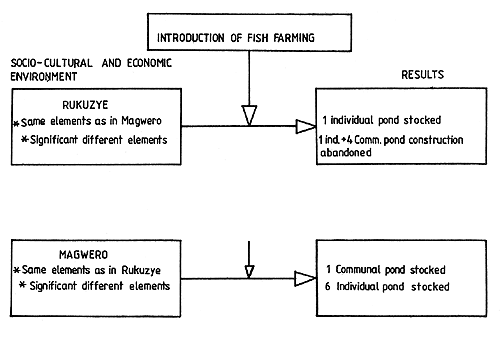ALCOM assisted the Department of Fisheries, Zambia to introduce fish farming in the two communities Rukuzye and Magwero in a pilot project, which started in 1987. During 1988 six ponds were under construction in Rukuzye but the construction of five of these was later abandoned. In Magwero Area seven ponds were constructed and stocked by mid 1989. Extension efforts have been more or less the same for both areas during the first year, ie. three visits per month.
A two-case comparison is used to illustrate the difference in uptake of fish farming in the two area's and the difference between adopters and non-adopters. A checklist of variables which may influence the adoption of fish farming, was compiled (see Appendix 1 and 2). For each variable it was calculated if they differed significantly in the two areas. The assumption is that these variables are a plausible explanation for the observed difference in interest in fish farming. The other elements are supposed to be more or less the same in both areas. A diagrammatic version of the study framework is found in figure 1.
Figure 1 : Diagram of the two area comparison

It is realized that this two-case comparison is not enough a basis for demonstration of causal relationships. To demonstrate that some factors are held constant in two areas and that there are no other elements that remain uncontrolled, would be an enormous task. One can always claim that some other crucial variable (which has not been investigated) accounts for the observed covariation of two variables. This study therefore does not pretend to give causal relationships but intends to be explorative in nature and show some empirically demonstrable relationships. The explanation of how factors relate to each other is post hoc and based on information obtained during fieldwork. The hypotheses thus developed could be further tested for their causality.